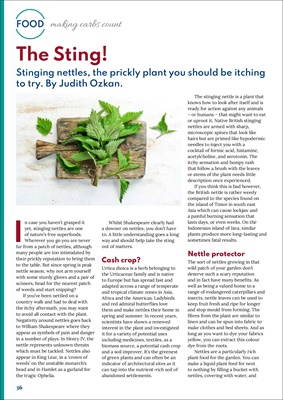
36
FOOD making carbs count
The Sting!
Stinging nettles, the prickly plant you should be itching
to try. By Judith Ozkan.
In case you haven't grasped it
yet, stinging nettles are one
of nature's free superfoods.
Wherever you go you are never
far from a patch of nettles, although
many people are too intimidated by
their prickly reputation to bring them
to the table. But since spring is peak
nettle season, why not arm yourself
with some sturdy gloves and a pair of
scissors, head for the nearest patch
of weeds and start snipping?
If you've been nettled on a
country walk and had to deal with
the itchy aftermath, you may want
to avoid all contact with the plant.
Negativity around nettles goes back
to William Shakespeare where they
appear as symbols of pain and danger
in a number of plays. In Henry IV, the
nettle represents unknown threats
which must be tackled. Nettles also
appear in King Lear, in a 'crown of
weeds' on the unstable monarch's
head and in Hamlet as a garland for
the tragic Ophelia.
Whilst Shakespeare clearly had
a downer on nettles, you don't have
to. A little understanding goes a long
way and should help take the sting
out of matters.
Cash crop?
Urtica dioica is a herb belonging to
the Urticaceae family and is native
to Europe but has spread fast and
adapted across a range of temperate
and tropical climate zones in Asia,
Africa and the Americas. Ladybirds
and red admiral butterflies love
them and make nettles their home in
spring and summer. In recent years,
scientists have shown a renewed
interest in the plant and investigated
it for a variety of potential uses
including medicines, textiles, as a
biomass source, a potential cash crop
and a soil improver. It's the greenest
of green plants and can often be an
indicator of architectural sites as it
can tap into the nutrient-rich soil of
abandoned settlements.
The stinging nettle is a plant that
knows how to look after itself and is
ready for action against any animals
- or humans - that might want to eat
or uproot it. Native British stinging
nettles are armed with sharp,
microscopic spines that look like
hairs but are primed like hypodermic
needles to inject you with a
cocktail of formic acid, histamine,
acetylcholine, and serotonin. The
itchy sensation and bumpy rash
that follow a brush with the leaves
or stems of the plant needs little
description once experienced.
If you think this is bad however,
the British nettle is rather weedy
compared to the species found on
the island of Timor in south east
Asia which can cause lockjaw and
a painful burning sensation that
lasts days, or even weeks. On the
Indonesian island of Java, similar
plants produce more long-lasting and
sometimes fatal results.
Nettle protector
The sort of nettles growing in that
wild patch of your garden don't
deserve such a scary reputation
and in fact have many benefits. As
well as being a valued home to a
range of endangered caterpillars and
insects, nettle leaves can be used to
keep fruit fresh and ripe for longer
and stop mould from forming. The
fibres from the plant are similar to
linen and can be spun into fabric to
make clothes and bed sheets. And as
long as you want to dye your fabrics
yellow, you can extract this colour
dye from the roots.
Nettles are a particularly rich
plant food for the garden. You can
make a liquid plant feed for next
to nothing by filling a bucket with
nettles, covering with water, and